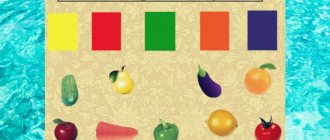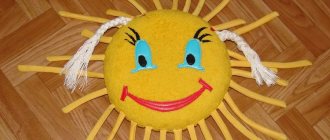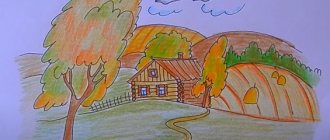MAGAZINE Preschooler.RF
Municipal budgetary preschool educational institution “Kindergarten No. 25 “Fairy Tale”” was prepared by teacher Napolskikh Larisa Sergeevna, Naberezhnye Chelny 2014 Goal: to have an idea of how bread is grown, to respect people who grow bread, to show interest in new knowledge. Objectives: • to give children knowledge about bread as the main wealth of man; • to introduce children to a new material for modeling - salted dough; learn to sculpt from salted dough, using familiar modeling techniques • develop dough techniques, creativity, fine motor skills of the hands • cultivate respect for bread, the main product on the table Materials and equipment: pictures, photographs, samples of cereals, proverbs and sayings about bread, ready-made salted dough Preliminary work: looking at illustrations, reading fiction about bread, reading poems and proverbs, preparing salt dough. Vocabulary work: baked goods, barn, kneading Preliminary work with children: conversation about how grain is grown, looking at pictures, excursions to a bakery store, reading poems and proverbs about bread, memorizing a poem for physical education, reading fiction Integration of educational areas: artistic creativity (modelling), cognition, communication, socialization, reading fiction. Types of children's activities: play, cognitive-research, communicative, productive. Introductory part. Educator: Listen to a poem about bread: Here it is, fragrant bread, Here it is warm, golden. He came to every house, to every table. It contains our health, strength, and wonderful warmth. How many hands raised him, protected him, took care of him. In it is the juice of the native land, the sun is the cheerful light in it... Grasp it by both cheeks, grow up to be a hero! Educator: Today we will talk about how they baked bread in the old days. Educator: -Tell me why they say “Bread is the head of everything?”, “What is bread made from?”, “What is another name for bread?” (example answers from children) Educator: - Guys, listen to the proverbs about bread: - “With bread, all food is delicious” - “Don’t open your mouth to someone else’s loaf” “Sweat on your back, so is bread on the table” Bread is the main product in our table. We cannot imagine our life without bread. But for bread to get to our table, it must travel a long way. After harvesting, the grain was ground in mills to produce flour. Then the flour was taken to the barns. A barn is a warehouse, a pantry where grains and cereals were stored. Educator: Now I will show you a simple way to obtain flour from wheat grains. (The teacher pours wheat grains into the coffee grinder and invites the children to observe what happens) Educator: The result is wheat cereal, from which you can cook delicious wheat porridge at home and in kindergarten. Well, if you grind longer, you get wheat flour. To bake bread, flour had to be sifted through a sieve. This was necessary so that debris did not get in and the flour became airy. Then the housewife kneaded the dough in a kneading bowl. Kvashnya is a wooden utensil for baking bread. When the dough rose, it was laid out on frying pans, and if there were none, on iron or simply placed on bricks. Bread was baked in the oven and taken out with wooden shovels. They took the fragrant bread out of the oven and covered it with towels so that it became soft. They cut off the top of the loaf, and a wonderful smell spread throughout the entire hut. Educator: -Tell me what else you baked from flour? (pies, cheesecakes, buns, bagels, etc.) (showing pictures)The main part of the GCD: Finger gymnastics “Spikelet” Educator: To make our fingers obedient, let’s stretch them. And we plowed the arable land, plowed deep furrows. (imitation of digging) The furrows are deep, the stripes are wide (hands up) We sow, sow, sow (imitation of sowing) We throw the grain into the arable land Go into the warm ground Rise up to the sun. (stretching upward) And we are young reapers, We have golden sickles. (imitation of the harvest) We reaped our lives, laid them in stacks in the fields, and put pies on the table. (imitation of an invitation to the table)
Educator: And now you will all be bakers. Put on your aprons and go to our bakery (children sit at the tables). The teacher invites the children to make gingerbread cookies, bagels, cookies, pies, loaves, etc. from salt dough for the game. During the work, the teacher helps and suggests how to decorate. Result: All the guys are great! Everyone worked hard and made so many baked goods. (At the end of the lesson, all works must be reviewed. Then the products are placed on a baking sheet and taken to the kitchen for baking).
List of used literature: 1. Averina I.E. Physical education minutes and dynamic pauses in preschool educational institutions: practical work. allowance / I.E. Averina. – 4th ed. – M.: Iris-press, 2008. 2. Komarova T.S. Lessons in visual arts in kindergarten: Book. for a kindergarten teacher garden – M.: Mozaika-Sintez, 2008. 3. Veraksa N.E., Komarova T.S., Vasilyeva M.A. From birth to school. Sample basic general education program for preschool education. – M.: Mosaika-Sintez, 2011.
| Next > |
Salt dough recipe for bread and rolls
Salted dough for making miniature pastries should be plastic. The recipe is simple, the ingredients are available.
You will need:
- Fine salt
- 200 g. We use Extra salt, without the addition of iodine, it is sold in a pack with a blue seal. - Flour
– 200 g. How to measure the required amount of flour and salt? If you have kitchen scales, there will be no difficulties. If there are no scales, you will have to measure with glasses or cups. Please note that weight and volume are different things; salt is much heavier than flour. We use the tips of experienced dough makers - take 1.5 cups of flour for 1 glass of salt. We do not compact the latter. - Water
– approximately 150 ml. Why "approximately"? The fact is that the flour is different, and you may need either a little less or a little more water. - PVA glue
– 1-1.5 tbsp. spoons. - Vegetable oil
– 1-15 tbsp. spoons.
The process of making salt dough is simple.
1. Pour water into a separate container, add PVA and vegetable oil. Mix.
2. Mix flour and salt in a bowl.
3. Pour the liquid gradually into the mixture of flour and salt. Mix the dough. No long kneading is required, just a couple of minutes.
4. Place the ball of dough in a plastic bag or wrap it in film. You can sculpt immediately after kneading, although some masters leave it to sit for an hour. We wrap it in film so that the dough does not dry out - its top layer dries out very quickly, and crumbs may form when sculpting.
How to make bakery crafts from salt dough
Everything is extremely simple. We pinch off a small piece of dough from the ball and form the product we need: bread, bun, bagel, braid, etc.
We sculpt on a dry kitchen board. We put it on the same board - wooden or plastic. We do not lubricate the boards with anything.
If you need to connect the parts of the product, glue them together using ordinary water. Since salt dough crafts are small, it is convenient to use a brush when gluing.
GCD on modeling from salt dough" "Bread products". Testoplasty.
. Topic: “Bakery Products.” Testoplasty.
Goals and objectives:
· Introduce different types of bakery products;
· Clarify and consolidate knowledge about bakery products;
· Continue to develop children's creative imagination, fine and gross motor skills, memory, thinking, and eye;
· Develop the ability to convey the shape of familiar objects, their proportions, using previously learned modeling techniques;
· Cultivate accuracy and a positive attitude towards your work through the introduction of innovative technologies.
Preliminary work: - memorizing sayings and poems about bakery products; - looking at illustrations.
Vocabulary work: kneading, pinching, rolling.
Materials and equipment for the lesson: dough, modeling boards, stacks, napkins, rolling pins, samples of molded bakery products.
Modern educational technologies: health-saving, information and communication technologies, collaborative learning.
Progress of the lesson
Educator: - Guys, guests will come to us today.
— What do you think we can treat our guests to?
— Give me some tea (children’s answers)
Educator: - Yes, that’s right, but what can we offer for tea, made with our own hands?
(children's answers) - buns, muffins, pies, pretzels, bagels, baskets.
Educator: Guys, probably all these bakery products grow on trees, and we can pick them and serve them to the guests?
Children: No, does bread grow in the field?
Educator: Correct! I will now show you how bread gets to our table. (Demonstration of the presentation “Bread is the head of everything”)
Educator: You watched the presentation and, probably, you can tell me: What are the people who grow bread called? (grain growers)
—Where is grain transported by car from the fields? (to the elevator)
— What is an elevator? (building where grain is stored)
— What happens next to the grain?
From the elevator, the grain is transported to a flour mill, where flour is obtained from the grains, and then taken to a bakery, where bread is baked.
Educator: Well done! I suggest you take part in the process of obtaining flour and take the grain to the flour mill.
Physical exercise.
We are going to the field (children stand one after another and “drive” by car)
They hit a bump (they jump up, squat, make turns to the right, left)
We drove into a hole
We went around the hills
And the plant has arrived!
Educator: So we took the grain to the flour mill, and while our flour is ready, I suggest you go to your places.
Teacher: draws attention to the box standing on the table. He offers to solve riddles and with each answer he takes out a picture or a replica of a baked product from the box.
Lesson for the preparatory group. Modeling “Bread, bakery products” (from salt dough)
Belskaya Irina Nikolaevna, teacher
The article belongs to the section: Working with preschoolers
Tasks:
- Teach children to think about the content of their work based on personal experience.
- Clarify and consolidate children's knowledge about bakery products.
- To develop the ability to convey the shape of familiar objects, their proportions, using previously learned modeling techniques.
Preliminary work: reading the story by G. Lagzdyn “The Adventures of the Bread Man”, S. Shurtakov “The Grain Fell into the Ground”, the Belarusian folk tale “Light Bread”. Learning sayings about bread, looking at baked goods in a bread store (excursion to a bread store), reading poems by D. Kugultinov “A Piece of Bread”, H. Myand “Bread”, K. Kubilinskas “Sheaves”, the story by E. Shim “Bread Grows” .
Progress:
1. Organizational moment.
The teacher invites the children to play the game “Magic Ball”. (lesson summary from ds50.ru) Children stand in a circle and take turns passing the ball to each other, naming the baked goods.
After the game, the teacher draws the children’s attention to the fact that there are role-playing games in the group.
But the children's favorite game is the store. Today in class we will enrich the role-playing game “Shop” with bakery products. 2. Updating knowledge.
The teacher asks questions:
—Where does the bread that is sold in the store come from?
— What grain crops do you know? (corn, wheat, rye, barley, oats).
—Where does bread grow? (in field)
—What are the people who grow bread called? (grain growers)
—Where is grain transported by car from the fields? (to the elevator)
— What is an elevator? (building where grain is stored)
— What happens next to the grain?
From the elevator, the grain is transported to a flour mill, where flour is obtained from the grains, and then taken to a bakery, where bread is baked.
Physical exercise.
We are going to the field (children stand one after another and “drive” by car)
They drove over a hummock
(they jump up, squat, make turns to the right, left)
They drove into a hole They drove around the hills And they arrived at the field!
The teacher invites the children to go to their places.
- Guys, who bakes the bread? (bakers)
Today we will be bakers, we will make bread products with our own hands. (lesson notes from ds50.ru) Children look at pictures depicting bread products.
Gymnastics for the eyes:
Blink quickly, close your eyes and sit quietly, slowly counting to 5.
On the count of 5, open your eyes.
The teacher draws attention to the box standing on the table. He offers to solve riddles and with each answer he takes out a picture or a replica of a baked product from the box.
There's wheat in the mill. This is what's happening to it! They take it into circulation and grind it into powder! (Flour)
It comes with rice, with meat, and with sweet cherries. First they put him in the oven, and when he comes out, they put him on a dish. Well, now call the guys. They'll all eat a piece. (Pie)
I bubble and puff, I don’t want to live in a kettle. I'm tired of the kneading, put me in the oven. (Dough)
What do they pour into a frying pan and bend it four times? (Pancakes)
Small, buttery, edible wheel. (Bagel)
Sits on a spoon with his legs dangling? (Noodles)
The ingredients are simple: flour, water, and the result is food, funny curls, straws, horns, ears. (Pasta)
At the same time, the teacher pays attention to the children’s correct posture and reminds them how to work with a stack (rules for working with a stack).
Finger gymnastics: “Kneading the dough”
- We kneaded the dough, we kneaded the dough, We were asked to knead everything thoroughly, But no matter how much we knead and how much we knead, we get lumps again and again.
3. Practical work
(Teacher instructions)
The teacher invites the children to think and choose what bakery products they will make. Remind different sculpting techniques. If the children are planning to sculpt
- Cake, then the teacher explains to the children that they need to roll up a thick cake and cut out ¼ of it as if you were cutting yourself a piece of cake. The top of the cake can be decorated with a cherry or a candle made from salt dough.
- In order to make bread, we roll a ball and form it into a brick that resembles a loaf of bread.
- We make bread straws by rolling out the dough with straight hand movements.
- Bagels and bagels, roll out the dough and roll the stick into a ring (connect the ends). Pretzels, roll out the dough with straight movements of your palms and roll the sausage in different ways.
- For cookies, gingerbread, roll out the dough in a circular motion and flatten the ball.
(Children doing work)
4. Summary of the lesson
- Guys, tell me why bread is called the most important thing in the house?
— How should you treat bread?
— Why do we need to respect the work of people who grow bread?
At the end of the lesson, the teacher examines the products together with the children, selects the best ones and leaves them to dry, so that at the next lesson he can paint the products.
More lesson notes for kindergartens: Children and etiquette (comprehensive-targeted program)
|
Journey to the land of fairy tales
|
Building creativity through unconventional drawing
|
Integrated lesson on artistic and productive work “In the old days there were grandfathers...”
|
Work program for the development of psychomotor skills of children 3–4 years old
|
Secrets of the Button
|
occupation | class notes | preparatory | preparatory group | groups | groups of songs | modeling | modeling + plasticine | bread | bread recipe | bakery | bakery products | jewelry | salty | salty | test | dough | abstract | lesson notes | classes | children's | kindergarten | garden | activities in kindergarten | Kindergarten lesson notes | Lesson for the preparatory group Modeling Bread bakery products from salt dough lesson notes in kindergarten | occupation | class notes | for | preparatory | preparatory group | groups | groups of songs | modeling | modeling from plasticine | bread | bread recipe | bakery | bakery products | jewelry | salty | salty | test | dough | abstract | lesson notes | classes | children's | kindergarten | garden | activities in kindergarten | Kindergarten lesson notes | Lesson for the preparatory group Modeling Bread bakery products from salt dough lesson notes in kindergarten | kindergartens
|
Blitz tournament “Connoisseurs of Art” between parents and children of the senior group lesson notes in kindergarten
|
Summary of a lesson on introducing fiction to children of the preparatory group with a compensatory orientation; summary of a lesson in kindergarten
|
Why should we build a city?
lesson notes in kindergarten |
Summary of a lesson on ecology with elements of TRIZ and mnemonics, summary of a lesson in kindergarten
|
Project to familiarize middle-aged and older preschoolers with nature “Basket tree and honey tree” (Linden) lesson notes in kindergarten
|
Folklore as a means of developing the moral and emotional sphere of a child.
Folklore lesson “The hut is made of brick, sometimes cold, sometimes hot” lesson notes in kindergarten |
Integrated entertainment “Rescue Service” (for a pre-school group) lesson notes in kindergarten
|
Integrated lesson for children of middle preschool age “On a visit to Zimushka-winter” lesson notes in kindergarten
|
Project “Warmth of the Hearth” lesson notes in kindergarten
|
Lesson for elementary school students “Journey to the world of medicinal plants” lesson notes in kindergarten
|
A series of lessons on music education “Northern tunes” in kindergarten, lesson notes in kindergarten
|
Games and exercises with young children with deviations in psychophysical development; lesson notes in kindergarten
|
lesson notes | school activities | making love | notes for lessons in kindergarten | preparatory group | lesson in the preparatory group | didactic games in the preparatory group | projects in the preparatory group | download group | junior group | torrent group | musical groups | modeling from plasticine | modeling lesson | modeling lesson senior group | modeling for 3 years | bread recipe | loaf of bread | bread of the tongue | ooo bread | bakery products | production of bakery products | photos of bakery products | bakery industry | jewelry | product manufacturing | jewelry factory | finished product | pickles | salt dough | salted salmon recipe | salted mackerel recipe | test drive | iq test | 10th grade tests | lesson notes | plan outline | abstract on the world around us | lesson notes for the senior group | lesson topics | lesson planning | having sex | kindergarten | children's song | children's rooms | download song children's songs | sad group | groups in kindergarten | DIY garden | garden plan | Kindergarten lesson notes | senior kindergarten group classes | Lesson | for | preparatory | groups | Modeling | Bread | bakery | products | from | salty | test | abstract | classes | in | children's | garden | Lesson for the preparatory group Modeling Bread bakery products from salt dough lesson notes in kindergarten
| author: Belskaya Irina Nikolaevna, teacher (source) |






